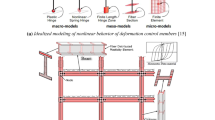Abstract
This paper focuses on the investigation of a hybrid seismic isolation system with passive variable friction dampers for protection of structures against near fault earthquakes. The seismic isolation can be implemented by replacing the conventional columns fixed to the foundations by seismic isolating ones. These columns allow horizontal displacement between the superstructure and the foundations and decouple the building from the damaging earthquake motion. As a result, the forces in the structural elements decrease and damage that may be caused to the building by the earthquake significantly decreases. However, this positive effect is achieved on account of displacements occurring in the isolating columns. These displacements become very large when the structure is subjected to a strong earthquake. In this case, impact may occur between the parts of the isolating column yielding their damage or collapse. In order to limit the displacements in the isolating columns, it is proposed to add variable friction dampers. A method for selecting the dampers’ properties is proposed. It is carried out using an artificial ground motion record and optimal active control algorithm. Numerical simulation of a sevenstory structure shows that the proposed method allows efficient reduction in structural response and limits the displacements at the seismic isolating columns.
Similar content being viewed by others
References
Al-Hussaini TM, Zayas VA, Constantinou MC (1994), “Seismic Isolation of Multi-story Frame Structures Using Spherical Sliding Isolation Systems,” Technical Report NCEER 94-0007, State University of New York at Buffalo, Department of Civil Engineering, Buffalo, NY.
Ariga T, Kanno Y and Takewaki I (2006), “Resonant Behaviour of Base-isolated High-rise Buildings Under Long-period Ground Motions,” The Structural Design of Tall and Special Buildings, 15: 325–338.
Barbat AH, Rodellar J, Ryan EP and Molinares N (1995), “Active Control of Nonlinear Base-isolated Buildings,” Journal of Engineering Mechanics, 121(6): 676–685.
Briman V and Ribakov Y (2006), “Seismic Isolation Columns for Earthquake-resistant Structures,” The Structural Design of Tall and Special Buildings, 17(1): 99–116.
Briman V and Ribakov Y (2009), “Using Seismic Isolation Columns for Retrofitting Buildings with Soft Stories,” The Structural Design of Tall and Special Buildings, 18: 507–523.
Buckle IG and Mayes RL (1990), “Seismic Isolation: History, Application, and Performance — a World View,” Earthquake Spectra, 6(2): 161–201.
Casciati F, Faravelli L and Hamdaoui K (2007), “Performance of a Base Isolator with Dhape Memory Alloy Bars,” Earthquake Engineering and Engineering Vibration, 6(4): 401–408.
Choi KM, Jung HJ, Lee HJ and Cho SW (2008), “Seismic Protection of Base-isolated Building with Nonlinear Isolation System Using Smart Passive Control Strategy,” Structural Control and Health Monitoring, 15(5): 785–796.
Control System Toolbox For Use with MATLAB — User’s Guide, The MathWorks, Inc., 1999.
Gluck J, Ribakov Y and Dancygier AN (2000), “Selective Control of Base Isolated Structures with CS Dampers,” Earthquake Spectra, 16: 593–606.
Kelly JM (1981), “Aseismic Base Isolation: History and Prospects,” Proc. 1st World Congress on Joints and Bearings, ACI-SP-70, 1: 549–586.
Kelly JM (1991), “Base Isolation: Origins and Development,” News — Earthquake Engineering Research Center, 12(1): 1–3.
Kelly JM (1999), “The Role of Damping in Seismic Isolation,” Earthquake Engineering and Structural Dynamics, 28: 3–20.
Lin PY, Roschke PN and Loh CH (2007), “Hybrid Baseisolation with Magnetorheological Damper and Fuzzy Control,” Structural Control & Health Monitoring, 14(3): 384–405.
Loh CH, Wu LY and Lin PY (2003), “Displacement Control of Isolated Structures with Semi-active Control Devices,” Journal of Structural Control, 10(2): 77–100.
Lu LY, Lin GL and Kuo TC (2008), “Stiffness Controllable Isolation System for Near-fault Seismic Isolation,” Engineering Structures, 30(3): 747–765.
Mayes RL (1989), “Design of Structures with Seismic Isolation,” The Seismic Design Handbook, New York: Van Nostrand Reinhold, pp. 413–438.
Naeim F and Kelly JM (1999), Design of Seismic Isolated Structures, New York: John Wiley & Sons, Inc..
Nagarajaiah S and Sahasrabudhe S (2006), “Seismic Response Control of Smart Sliding Isolated Buildings Using Variable Stiffness Systems: an Experimental and Numerical Study,” Earthquake Engineering and Structural Dynamics, 35: 177–197.
Narasimhan S and Nagarajaiah S (2005), “STFT Algorithm for Semiactive Control of Base Isolated Buildings with Variable Stiffness Isolation Systems Subjected to Near Fault Earthquakes,” Engineering Structures, 27(4): 514–523.
Nobuyuki O, Hiroyuki A, Yasufumi K and Toshio M (2006), “Design Example of Base-isolated High-rise Building with Large Aspect Ratio,” Kumagai Technical Research Report, 64: 53–60.
Ribakov Y, Blostotsky B and Iskhakov I (2005), “Modeling and Design of Variable Friction Dampers for Improving Seismic Response of Structures,” The Tenth International Conference on Civil and Structural Engineering Computing, Rome, 30 August–02 September 2005, Paper 209.
Ribakov Y, Blostotsky B and Iskhakov I (2006), “Theoretical Model and Laboratory Tests of a Variable Friction Damper,” European Earthquake Engineering, 20(1): 43–47.
Ribakov Y and Gluck J, (2002), “Selective Controlled Base Isolation System with Magnetorheological Dampers,” Earthquake Engineering and Structural Dynamics, 31(6): 1301–1324.
Ruangrassamee A, Srisamai W and Lukkunaprasit P (2006), “Response Mitigation of the Base Isolated Benchmark Building by Semi-active Control with the Viscous-plus-variable-friction Damping Force Algorithm,” Structural Control and Health Monitoring, 13(2–3): 809–822.
Soong TT (1990), Active Structural Control: Theory and Practice, NY: John Wiley & Sons, Inc.
Soong TT and Constantinou MC (1994), Passive and Active Structural Vibration Control in Civil Engineering, New York: Springer-Verlag.
Stewart JP, Conte JP and Aiken ID (1999), “Observed Behavior of Seismically Isolated Buildings,” Journal of Structural Engineering, ASCE, 125(9): 955–964.
Tezan S and Civi A (1979), “Reduction in Earthquake Response of Structures by Means of Vibration Isolation,” Proceedings of the Second U.S. National Conference on Earthquake Engineering, pp. 433–442.
Wongprasert N and Symans MD (2005), “Experimental Evaluation of Adaptive Elastomeric Base-isolated Structures Using Variable-orifice Fluid Dampers,” Journal of Structural Engineering, 131(6): 867–877.
Zayas V, Low S and Mahin S (1990), “A Simple Pendulum Technique for Achieving Seismic Isolation,” Earthquake Spectra, 6(2): 317–334.
Author information
Authors and Affiliations
Corresponding author
Rights and permissions
About this article
Cite this article
Ribakov, Y. Reduction of structural response to near fault earthquakes by seismic isolation columns and variable friction dampers. Earthq. Engin. Engin. Vib. 9, 113–122 (2010). https://doi.org/10.1007/s11803-010-9059-7
Received:
Accepted:
Published:
Issue Date:
DOI: https://doi.org/10.1007/s11803-010-9059-7




